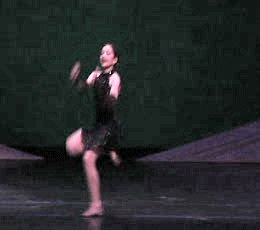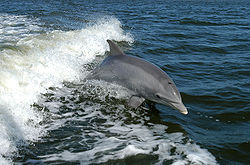
Jumping
Encyclopedia

Organism
In biology, an organism is any contiguous living system . In at least some form, all organisms are capable of response to stimuli, reproduction, growth and development, and maintenance of homoeostasis as a stable whole.An organism may either be unicellular or, as in the case of humans, comprise...
or non-living (e.g., robotic
Robotics
Robotics is the branch of technology that deals with the design, construction, operation, structural disposition, manufacture and application of robots...
) mechanical system propels itself through the air along a ballistic trajectory. Jumping can be distinguished from running, galloping, and other gait
Gait
Gait is the pattern of movement of the limbs of animals, including humans, during locomotion over a solid substrate. Most animals use a variety of gaits, selecting gait based on speed, terrain, the need to maneuver, and energetic efficiency...
s where the entire body is temporarily airborne by the relatively long duration of the aerial phase and high angle of initial launch.
Some animals, such as the kangaroo
Kangaroo
A kangaroo is a marsupial from the family Macropodidae . In common use the term is used to describe the largest species from this family, especially those of the genus Macropus, Red Kangaroo, Antilopine Kangaroo, Eastern Grey Kangaroo and Western Grey Kangaroo. Kangaroos are endemic to the country...
, employ jumping (commonly called hopping in this instance) as their primary form of locomotion
Animal locomotion
Animal locomotion, which is the act of self-propulsion by an animal, has many manifestations, including running, swimming, jumping and flying. Animals move for a variety of reasons, such as to find food, a mate, or a suitable microhabitat, and to escape predators...
, while others, such as frog
Frog
Frogs are amphibians in the order Anura , formerly referred to as Salientia . Most frogs are characterized by a short body, webbed digits , protruding eyes and the absence of a tail...
s, use it only as a means to escape predators. Jumping is also a key feature of various activities and sports, including the long jump
Long jump
The long jump is a track and field event in which athletes combine speed, strength, and agility in an attempt to leap as far as possible from a take off point...
, high jump
High jump
The high jump is a track and field athletics event in which competitors must jump over a horizontal bar placed at measured heights without the aid of certain devices in its modern most practiced format; auxiliary weights and mounds have been used for assistance; rules have changed over the years....
, and show jumping
Show jumping
Show jumping, also known as "stadium jumping," "open jumping," or "jumpers," is a member of a family of English riding equestrian events that also includes dressage, eventing, hunters, and equitation. Jumping classes commonly are seen at horse shows throughout the world, including the Olympics...
.
Physics of jumping

Jumping organisms are rarely subject to significant aerodynamic forces and, as a result, their jumps are governed by the basic physical laws of ballistic trajectories
Trajectory of a projectile
In physics, the ballistic trajectory of a projectile is the path that a thrown or launched projectile will take under the action of gravity, neglecting all other forces, such as friction from air resistance, without propulsion....
. Consequently, while a bird may jump into the air to initiate flight, no movement it performs once airborne is considered jumping, as the initial jump conditions no longer dictate its flight path.
Following the moment of launch (i.e., initial loss of contact with the substrate), a jumper will traverse a parabolic path. The launch angle and initial launch velocity determine the travel distance, duration, and height of the jump. The maximum possible horizontal travel distance occurs at a launch angle of 45 degrees, but any launch angle between 35 and 55 degrees will result in ninety percent of the maximum possible distance.
Muscles (or other actuator
Actuator
An actuator is a type of motor for moving or controlling a mechanism or system. It is operated by a source of energy, usually in the form of an electric current, hydraulic fluid pressure or pneumatic pressure, and converts that energy into some kind of motion. An actuator is the mechanism by which...
s in non-living systems) do physical work, adding kinetic energy
Kinetic energy
The kinetic energy of an object is the energy which it possesses due to its motion.It is defined as the work needed to accelerate a body of a given mass from rest to its stated velocity. Having gained this energy during its acceleration, the body maintains this kinetic energy unless its speed changes...
to the jumper's body over the course of a jump's propulsive phase. This results in a kinetic energy
Kinetic energy
The kinetic energy of an object is the energy which it possesses due to its motion.It is defined as the work needed to accelerate a body of a given mass from rest to its stated velocity. Having gained this energy during its acceleration, the body maintains this kinetic energy unless its speed changes...
at launch that is proportional to the square of the jumper's velocity. The more work the muscles do, the greater the launch velocity and thus the greater the acceleration and the shorter the time interval of the jump's propulsive phase.
Mechanical power
Power (physics)
In physics, power is the rate at which energy is transferred, used, or transformed. For example, the rate at which a light bulb transforms electrical energy into heat and light is measured in watts—the more wattage, the more power, or equivalently the more electrical energy is used per unit...
(work per unit time) and the distance over which that power is applied (e.g., leg length) are the key determinants of jump distance and height. As a result, many jumping animals have long legs and muscles that are optimized for maximal power according to the force-velocity relationship of muscles. The maximum power output of muscles is limited, however. To circumvent this limitation, many jumping species slowly pre-stretch elastic elements, such as tendon
Tendon
A tendon is a tough band of fibrous connective tissue that usually connects muscle to bone and is capable of withstanding tension. Tendons are similar to ligaments and fasciae as they are all made of collagen except that ligaments join one bone to another bone, and fasciae connect muscles to other...
s or apodemes, to store work as strain energy. Such elastic elements can release energy at a much higher rate (higher power) than equivalent muscle mass, thus increasing launch energy to levels beyond what muscle alone is capable of.
A jumper may be either stationary or moving when initiating a jump. In a jump from stationary (i.e., a standing jump), all of the work required to accelerate the body through launch is done in a single movement. In a moving jump or running jump, the jumper introduces additional vertical velocity at launch while conserving as much horizontal momentum as possible. Unlike stationary jumps, in which the jumper's kinetic energy at launch is solely due to the jump movement, moving jumps have a higher energy that results from the inclusion of the horizontal velocity preceding the jump. Consequently, jumpers are able to jump greater distances when starting from a run.
Anatomy
Animals use a wide variety of anatomical adaptations for jumping. These adaptations are exclusively concerned with the launch, as any post-launch method of extending range or controlling the jump must use aerodynamic forces, and thus is considered glidingGliding
Gliding is a recreational activity and competitive air sport in which pilots fly unpowered aircraft known as gliders or sailplanes using naturally occurring currents of rising air in the atmosphere to remain airborne. The word soaring is also used for the sport.Gliding as a sport began in the 1920s...
or parachuting
Parachuting
Parachuting, also known as skydiving, is the action of exiting an aircraft and returning to earth with the aid of a parachute. It may or may not involve a certain amount of free-fall, a time during which the parachute has not been deployed and the body gradually accelerates to terminal...
.
Aquatic species rarely display any particular specializations for jumping. Those that are good jumpers usually are primarily adapted for speed, and execute moving jumps by simply swimming to the surface at a high velocity. A few primarily aquatic species that can jump while on land, such as mud skippers, do so via a flick of the tail.
Limb morphology
In terrestrial animals, the primary propulsive structure is the legs, though a few species use their tails. Typical characteristics of jumping species include long legs, large leg muscles, and additional limb elements.Long legs increase the time and distance over which a jumping animal can push against the substrate, thus allowing more power and faster, farther jumps. Large leg muscles can generate greater force, resulting in improved jumping performance. In addition to elongated leg elements, many jumping animals have modified foot and ankle bones that are elongated and possess additional joints, effectively adding more segments to the limb and even more length.
Frogs are an excellent example of all three trends: frog legs can be nearly twice the body length, leg muscles may account for up to twenty percent of body weight, and they have not only lengthened the foot, shin and thigh, but extended the ankle bones into another limb joint and similarly extended the hip bones and gained mobility at the sacrum for a second 'extra joint'. As a result, frogs are the undisputed champion jumpers of vertebrates, leaping over fifty body lengths, a distance of more than eight feet.
Power amplification through stored energy
GrasshopperGrasshopper
The grasshopper is an insect of the suborder Caelifera in the order Orthoptera. To distinguish it from bush crickets or katydids, it is sometimes referred to as the short-horned grasshopper...
s are known to use elastic energy storage to increase jumping distance. As noted above, power output is a principal determinant of jump distance, but physiological constraints limit muscle power to approximately 375 Watts per kilogram of muscle. To overcome this limitation, grasshoppers anchor their legs via an internal "catch mechanism" while their muscles stretch an elastic apodeme (similar to a vertebrate tendon
Tendon
A tendon is a tough band of fibrous connective tissue that usually connects muscle to bone and is capable of withstanding tension. Tendons are similar to ligaments and fasciae as they are all made of collagen except that ligaments join one bone to another bone, and fasciae connect muscles to other...
). When the catch is released, the apodeme rapidly releases its energy. Because the apodeme releases energy more quickly than muscle, its power output exceeds that of the muscle that produced the energy.
This is analogous to a human throwing an arrow by hand versus using a bow; the use of elastic storage (the bow) allows the muscles to operate closer to isometric on the force-velocity curve. This enables the muscles to do work over a longer time and thus produce more energy than they otherwise could, while the elastic element releases that work faster than the muscles can. The use of elastic energy storage has been found in jumping mammals as well as in frogs, with commensurate increases in power ranging from two to seven times that of equivalent muscle mass.
Classification
One way to classify jumping is by the manner of foot transfer. In this classification system, five basic jump forms are distinguished:- Jump — jumping from and landing on two feet
- Hop — jumping from one foot and landing on the same foot
- Leap — jumping from one foot and landing on the other foot
- Assemble — jumping from one foot and landing on two feet
- Sissonne — jumping from two feet and landing on one foot
Leaping gaits, which are distinct from running
Running
Running is a means of terrestrial locomotion allowing humans and other animals to move rapidly on foot. It is simply defined in athletics terms as a gait in which at regular points during the running cycle both feet are off the ground...
gaits (see Locomotion
Animal locomotion
Animal locomotion, which is the act of self-propulsion by an animal, has many manifestations, including running, swimming, jumping and flying. Animals move for a variety of reasons, such as to find food, a mate, or a suitable microhabitat, and to escape predators...
), include canter
Canter
The canter is a controlled, three-beat gait performed by a horse. It is a natural gait possessed by all horses, faster than most horses' trot but slower than the gallop, and is used by all riders. The speed of the canter varies between 16-27 km/h , depending on the length of the stride of the horse...
ing, galloping, and pronging
Stotting
Stotting is a gait of quadrupeds, particularly gazelles , involving jumping high into the air by lifting all four feet off the ground simultaneously. This may occur during pursuit by a predator...
.
Devices and techniques for enhancing jumping height
The height of a jump may be increased by using a trampolineTrampoline
A trampoline is a device consisting of a piece of taut, strong fabric stretched over a steel frame using many coiled springs. People bounce on trampolines for recreational and competitive purposes....
or by converting horizontal velocity into vertical velocity with the aid of a device such as a half pipe.
Various exercises can be used to increase an athlete's vertical jumping height. One category of such exercises—plyometrics
Plyometrics
Plyometrics is a type of exercise training designed to produce fast, powerful movements, and improve the functions of the nervous system, generally for the purpose of improving performance in sports. Plyometric exercises may also be referred to as explosive exercises...
—employs repetition of discrete jumping-related movements to increase speed, agility, and power.
See also
- List of jumping activities
- Video game jumping: bunny hoppingBunny hoppingBunny hopping, or bunny jumping, is a term used in video games to describe the basic movement technique in which a player jumps repeatedly, instead of running, in order to move faster.-Concept:...
, rocket jumpingRocket jumpingIn first-person shooter computer and video games, rocket jumping is the technique of pointing a rocket launcher or other similar explosive weapon at the ground or at a wall then firing and jumping at the same time. The rocket's explosion propels the player to greater heights and distances than...
, strafe-jumpingStrafe-jumpingStrafe-jumping is a form of trickjump used to increase a player's speed in computer games based on the Quake engine and now the Doom 3 engine...
, trickjump

